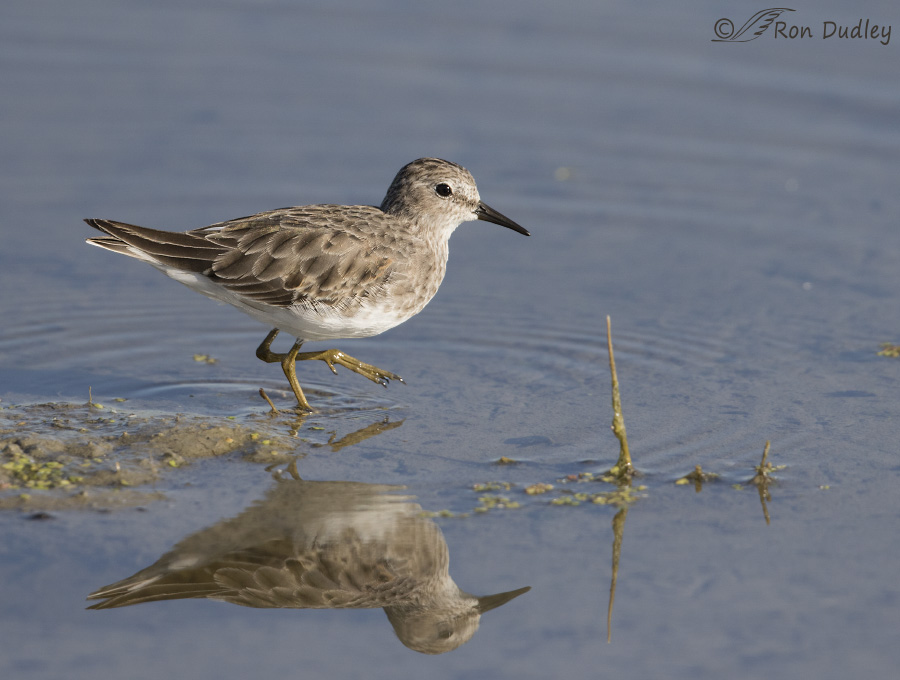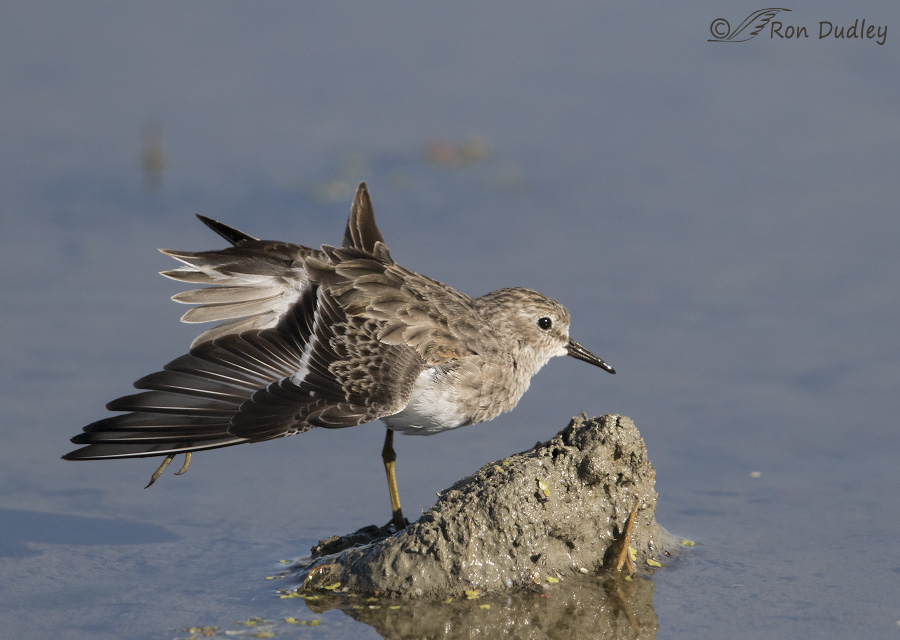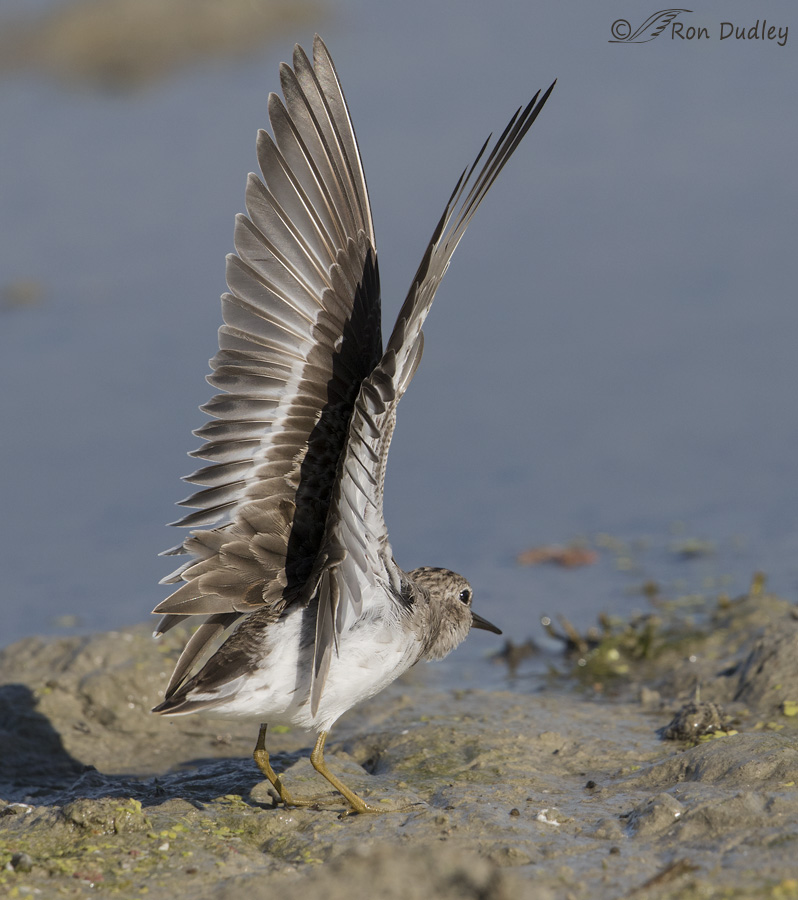The term “peeps” is common slang for the five smallest North American sandpipers and the Least Sandpiper is the smallest of the bunch. In fact they’re the smallest shorebird in the world.
 1/2000, f/6.3, ISO 640, Canon 7D Mark II, Canon EF500mm f/4L IS II USM +1.4 tc, not baited, set up or called in
1/2000, f/6.3, ISO 640, Canon 7D Mark II, Canon EF500mm f/4L IS II USM +1.4 tc, not baited, set up or called in
I photographed this one at Farmington Bay MBR two days ago as it foraged in the shallow water and mud. Their small size can be deceiving in a photo if there’s nothing in it for scale but these birds are even slightly smaller than a House Finch (.7 oz. vs .74 oz. for the finch). This bird was pretty timid as it hunkered down behind a small pile of mud for about a half hour before it ventured out but when it did it gave me plenty of photographic opportunities.

1/3200, f/6.3, ISO 640, Canon 7D Mark II, Canon EF500mm f/4L IS II USM +1.4 tc, not baited, set up or called in
It even gave me a nice wing stretch that included a fanned tail that is partially visible with its head facing only slightly away from me.

1/2500, f/7.1, ISO 640, Canon 7D Mark II, Canon EF500mm f/4L IS II USM +1.4 tc, not baited, set up or called in
But the bird didn’t fully cooperate when it performed a vertical wing stretch and gave me a butt shot instead. At least I got the eye with a catch light and even at this less than ideal angle I appreciate the look at all of the individual feathers of the fully extended left wing.
Least Sandpipers are long distance migrators, breeding in subarctic/boreal Alaska and northern Canada and wintering in Central America, northern South America and the southern U.S. Since they’re neither summer or winter residents in Utah I don’t have many opportunities with them. Many of my readers in the coastal states are likely quite familiar with this little sandpiper but finding this bird was quite an unusual treat for me.
Ron


Since I have house finches at my house feeder a lot, I instantly knew how small they were.
Love! The wing stretch is just remarkable!
I hadn’t realized the Least Sandpiper was REALLY Least! Smaller than a House Finch??? Incredible.
Yup, they’re very small, Deedee. The average North American hummingbird is about 3.5 grams or .12 oz so that also helps to put it in perspective.
Oops! Average NA Hummingbird might be about 3.5 GRAMS! There was a movie a few years ago, something about 23 grams. That was supposed to be the weight of a soul or a hummingbird. Used to crack me up, because a 23 gram hummingbird would be enormous. Adult House Finches run between 18-21 grams here in New Mexico. I’ve never seen a Least Sandpiper, but Sibley’s gives their weight as 20 grams. B
Boggling that it can be that tiny, even with those big wings.
You’re right, Mikal – I transposed typo and oz. Thanks for the heads up. I’ll correct it in my comment so I don’t mislead anyone down the road.
Most of the little brown jobs are beautiful – if we take the time to really look. Monochromatic marvels.
Love that stretch. And the flex before it.
“Monochromatic marvels”
Agreed, EC. You don’t have to look hard to find their beauty.
Yes it had yellow legs. I posted a photo on Birding in Utah. It’s not a clear shot but I think you can see a tinge of yellow on it’s leg.
I just looked at it. I think I see some yellow too but when those legs get muddy it can be hard to tell. Besides I’m not very good at all at identifying peeps.
Thank you for identifying this little bird. We were just out at Farmington Bay yesterday and I managed to get a couple of photos of the “little sandpiperish bird. They are fast and shy.
April, Did your bird have yellow legs? If so it was probably a Least but I also saw a Western Sandpiper nearby.
And I thought Sanderlings were small (they’re the smallest shore birds I’ve encountered). Looking at the outstretched wing in the last photo reminds me of the construction of some Native American headdresses. This bird may be one of EC’s “little brown jobs”, but it is absolutely beautiful. Great series!
“Looking at the outstretched wing in the last photo reminds me of the construction of some Native American headdresses.”
You’re right, Susan. I see the similarity. Thank you.
Great shots Ron! Also, wonderful looks at those all telling yellowish legs that besides size differentiate a Least from other peeps. When in the field that is one of the things I do when looking over a bunch of black legged peeps, is to look to see if I can see any yellow legs in the group.
Yup, as far as I know those yellow/green legs are the best field mark for them, Dick. Thank you.
Thanks for sharing this little guy with us, Ron!! I so love seeing them at the beach along with all the other shore birds. Their speed is amazing. Since they are never still, I so appreciate your photos to be able to really “see” them. I also have a book to let you know about. I just started reading David McCullough’s biography of “The Wright Brothers” which just came out in July of this year. I’m not too far but am really enjoying it. I just read the chapter where they have made their 2nd trip to Kitty Hawk and they spent many hours watching all the birds to see just how they flew to Improve their biplane. At the time they were there the Outer banks only had 50 homes that were really mostly fishermen’s shacks and the number and variety of birds was HUGE.
Sounds like an interesting book, Jo Ann. Anything that David McCullough is involved in is usually excellent. Thank you.
Jo Ann, I just finished reading that book, and it is wonderful all the way to the end. As are all of David McCullough’s books. I’ve read some history of the area because our family has a house in Duck, NC (just north of Kitty Hawk), and that town was named for all the Ducks that used to populate the area. If you ever have a chance, a visit to the Wright Brothers National Memorial in Kill Devil Hills is well worth it, as is a visit to everything Wright Brothers in Dayton, OH. I was very impressed that they were learning from the birds.
Thanks Susan!! Glad I caught your post. I have been lucky to visit the Outer Banks at the time they had just moved the Cape Hatteras lighthouse. I’m big into Lighthouses & have visited over 300!! While there we stayed in Mateo & could see the Bodie Lighthouse from our B & B. We were able to see Kitty Hawk & shopped in Duck, NC!!! I hope to get back one day because it is so beautiful.
Wow! Wow! Wow! What awesome shots of this timey little one Ron!
Charlotte
Thanks, Charlotte.
Hi! love your photo’s! miss seeing them in 2012 is the last time when I was out there visiting! Have a great day! rainy here in Va.
I’m glad you enjoy them, Hummingbird Lover. Thank you.
I’ll take a dozen…will settle for 6…I’ll flood the floor and put down 10″ of sand….and then just sit back and watch them….for hours!!!, They are so danged curvy and CUTE I can barely stand it!!!
Your enthusiasm for them makes me smile, Patty…
Wonderful photographs, Ron! When I look out over a sod field of migrating shorebirds, the peeps remind me of ants scurrying around among giants such as Killdeer. Very nice!
“Longtime peep chaser.”
Wally, I got a couple of photos of a Western Sandpiper with a Killdeer right behind it and you’re right – the comparison is like David and Goliath! Thank you.
Beautiful! Sure wouldn’t think they are as small as they are. The detail on the vertical wing stretch is great even if it did have it’s butt towards you.
Thanks, Judy. There was a Western Sandpiper in the same area and they’re not a lot bigger (.91 oz). It would have been fun to get the two of them in the same shot but it didn’t happen…